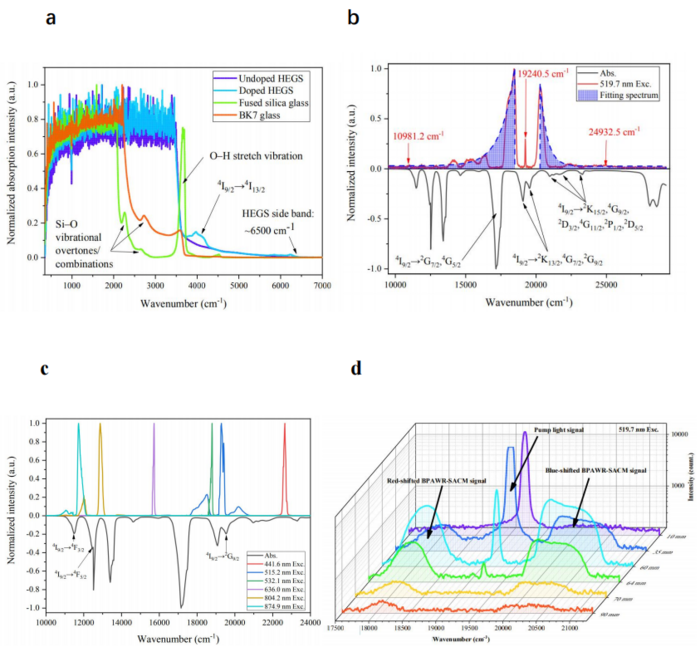Components of a typical laser include gain medium, laser pumping energy and resonant optical cavity. The output frequency of most lasers is fixed or within a small range, and it is difficult to generate lasers of some frequencies by common ways. Regarding some practical applications, optical frequency conversion technology which can convert the laser into new spectral components is employed to obtain coherent radiation with varying wavelengths. Nonlinear optical process dominates the frequency conversion technique, for example, designing specific energy levels to achieve fluorescence with tunable wavelengths, second-harmonic generation, sum- and difference- frequencies, etc. How to achieve spatial coherence of beams accompanying with modulating frequency is one of the most critical challenges.

Credit: by Linde Zhang, Jingyuan Zhang, Xiang Wang, Meng Tao, Gangtao Dai, Jing Wu, Zhangwang Miao, Shifei Han, Haijuan Yu and Xuechun Lin
Components of a typical laser include gain medium, laser pumping energy and resonant optical cavity. The output frequency of most lasers is fixed or within a small range, and it is difficult to generate lasers of some frequencies by common ways. Regarding some practical applications, optical frequency conversion technology which can convert the laser into new spectral components is employed to obtain coherent radiation with varying wavelengths. Nonlinear optical process dominates the frequency conversion technique, for example, designing specific energy levels to achieve fluorescence with tunable wavelengths, second-harmonic generation, sum- and difference- frequencies, etc. How to achieve spatial coherence of beams accompanying with modulating frequency is one of the most critical challenges.
In a new paper published in Light Science & Application, a team of scientists, led by Prof. Linde Zhang and Prof. Xuechun Lin from Laboratory of All-solid-state Light Sources, Being Engineering Research Center, Institute of Semiconductors, Chinese Academy of Sciences, China, and co-workers have applied the high-entropy strategy in an alternative glass phase system to realize a class of Nd3+ ions doped HEGS and intentionally designed its emission spectra by controlling absorption spectra. The absorption spectrum of the HEGS indicates the presence of high-frequency optical phonons or allowable multi-phonon processes in the system, which makes it exhibit a much stronger and wider infrared absorption than conventional glass system. Based on the HEGS, they identified a radiative de-excitation process consisting of a broadened-phonon-assisted wideband radiation (BPAWR) process and a subsequent self-absorption coherence modulation (SACM) process, i.e., BPAWR-SACM. Different from conventional nonlinear optical process like Raman, fluorescence and phosphorescence, the BPAWR-SACM can amplify the centered non-absorption band with a gain up to 26.02 dB. With a continuous-wave (CW) laser as pump, a modulated emission with wide-spectrum and spatial coherence can be obtained by designing the absorption spectrum of the system.
The HEGS is designed based on the close packing of oxides. From a mesoscopic view, many tetrahedral and octahedral voids are formed through close packing of O2-. Tetrahedral voids can be occupied by two classes of ions. One type of ions (i.e., Si4+, P5+, S6+) has simple geometric structures. Another type of ions (i.e., Li+, Zn2+) has a strong ability to induce polarization, which can cause lattice deformation for occupying interstices. The absorption spectrum of the HEGS indicates the presence of high-frequency optical phonons or allowable multi-phonon processes in the system, which makes it exhibit a much stronger and wider infrared absorption than conventional glass system. The broadened phonons and absorption modes can be jointly manipulated to generate the desired emission spectra, which can be tuned by changing excitation wavelengths, sample size, and doping concentrations of Nd3+ ions.
“Our scheme on the BPAWR-SACM is based on the combination of the line shape of the material’s absorption spectrum and the wavelength of pump lasers, through which spatially coherent light of desired wavelengths can be obtained. The BPAWR results from the high-frequency phonon modes or allowable multi-phonon process in the HEGS. The wideband radiation is permitted to propagate only in the non-absorption band of the medium, which consists of the blue-shifted band produced by the phonons’ self-absorption and the red-shifted band produced by the phonons emission. This process leads to SACM. The frequency components are changed accompanying the radiation propagation in the SACM process, which causes mode competition in the radiation process.” The scientists summarize the principles of their observations like this.
“Previous work reported that only when the radiation center has the electronic structure of a three-level, four-level or quasi-four-level system, it is possible for the radiation center to achieve population inversion by pumping, and then generate a beam with spatial & temporal coherence through the stimulated emission process. Our work suggests that without a mentioned-above electronic structure, the radiation center can yield a spatially coherent emission, as long as the absorption spectrum meets some requirements and there is a strong coupling between the radiation center and crystal matrix. Since the high-frequency phonon modes can cover a broad absorption spectrum up to thousands of wavenumbers, the corresponding emission spectrum of the phonon-assisted radiation process can also broaden by thousands of wavenumbers.” they added.
“The presented technique demonstrates the possibility of generating designable spatially coherent wide-band radiation without a resonant cavity. The optical frequency conversion can be achieved without a common nonlinear optics. With the BPAWR-SACM process, frequency modulation in the visible light range is possible, thereby realizing the wavelength division multiplexing communication technology. This breakthrough can offer a route for application in supercontinuum, laser amplification, and optical communication, etc.” the scientists forecast.
Journal
Light Science & Applications
DOI
10.1038/s41377-022-00848-y




